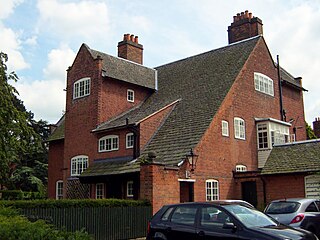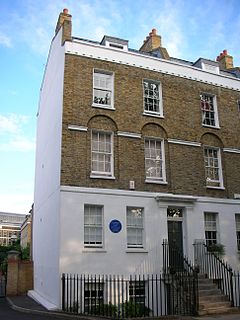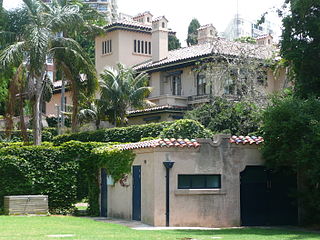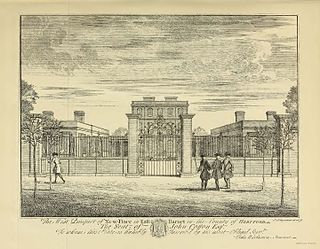
Highlands Gardens is a small park in New Barnet at the western end of Leicester Road, on the corner with Abbotts Road. The park was opened in 1931 in the grounds of Highlands House which was demolished in about 1972 and replaced by flats.

Highlands Gardens is a small park in New Barnet at the western end of Leicester Road, on the corner with Abbotts Road. The park was opened in 1931 in the grounds of Highlands House which was demolished in about 1972 and replaced by flats.


The park was opened in 1931 in the grounds of Highlands House which already had a well established set of gardens. The entrance is on the corner of Leicester Road and Abbotts Road. The gardens consist of a lawn terrace with a pergola walk on the north side and water and rock features on the western side. All four sides of the gardens include mature trees. The rockworks were probably the work of James Pulham and Son, around 1871, of nearby Broxbourne. An aviary by the name of the "Bird World Display Centre" existed on the northern edge of the gardens until the late 1990s. [1] The gardens are maintained by the London Borough of Barnet with help from the Friends of Highlands Gardens. [2]


Highlands House was built in 1897 for the banker Joseph Bevan Braithwaite (1855-1934) who is thought to have designed the gardens. The house was south facing on high ground that overlooked Leicester Road, New Barnet. Braithwaite was an amateur astronomer who had a copper-domed observatory built at the house with a telescope on rails offering 360 degree views of the sky. [3] During the Second World War, the dome was painted black in order to prevent it being visible to enemy aircraft in moonlight. [1]
In 1930, George P. Howe bought the house, or part of it, and converted it to eight flats that he rented out. Around 1951, the house became a family home again after Howe allowed his married children and his grandchildren to live there. His daughter, Joan Cochrane, recalled:
"The windows were by Crittall, and some contained leaded lights; the staircase of oak; the ground floor parquet. Terrazzo flooring was in the foyer and on the terrace. The walls in the hall and on the upper two landings were panelled. This was a substantial house, with the roof fully lined with wood beneath the tiles and the lofts boarded. There were several immense cellars linked by hatches and one of them contained a huge boiler which provided hot air to the ground floor via brass gratings in the parquet flooring. Drains and sewers were lined with glazed white tiles." [3]
By 1972 the house had deteriorated and it was demolished, eventually being replaced by a block of flats known as The Highlands. [3]

New Barnet is a neighbourhood on the north east side of the London Borough of Barnet. It is a largely residential North London suburb located east of Chipping Barnet, west of Cockfosters, south of the village of Monken Hadley and north of Oakleigh Park.

The Holly Lodge Estate is an estate in Highgate, London.

Stoneygate is part of the City of Leicester, England.

Meersbrook is a suburban district in the south-west of Sheffield, England bordered by Nether Edge to the west, Norton Lees to the south, Heeley to the north and the Meersbrook allotment site to the east. Until 1950 it was part of the Sheffield Ecclesall constituency and now forms part of the Sheffield Heeley constituency. The district falls within the Gleadless Valley ward of the city. The name comes from the stream, the Meers Brook, a tributary of the River Sheaf which means 'boundary brook' and in ancient times this, along with the River Sheaf formed the boundary between the Anglo-Saxon kingdoms of Northumbria and Mercia. It remained as the boundary between Yorkshire and Derbyshire into the 20th century. Meersbrook itself was once several small communities which have given many roads their names; Rush Dale, Carfield & Cliffe Field and in 1857 was known as Mears Brook.
The London Borough of Barnet, located on the northern periphery of London and having much of the area within its boundaries in the Metropolitan Green Belt, has many parks and open spaces. In addition there are large areas taken over by cemeteries and golf courses, and part of Hampstead Heath.

West Square is a historic square in south London, England, just south from St George's Road. The square is within the London Borough of Southwark, but as it is located in postcode SE11, it is commonly said to be in Lambeth.
Solomon Andrews was a British entrepreneur and head of the Solomon Andrews and Son bus and tram-operating company, based in Cardiff.

Hillsborough Barracks is a walled complex of buildings between Langsett Road and Penistone Road in the Hillsborough District of Sheffield, South Yorkshire, England.

Sydenham Hill Wood is a ten-hectare wood on the northern slopes of the Norwood Ridge in the London Borough of Southwark. It is designated as a Local Nature Reserve and Site of Metropolitan Importance for Nature Conservation. With the adjacent Dulwich Wood, Sydenham Hill Wood is the largest extant tract of the ancient Great North Wood. The two woods are formed from coppices known as Lapsewood, Old Ambrook Hill Wood and Peckarmans Wood after the relocation of The Crystal Palace in 1854 and the creation of the high level line in 1865.

Boomerang is a heritage-listed private house and garden located at 42 Billyard Avenue in the inner eastern Sydney suburb of Elizabeth Bay, in the City of Sydney local government area of New South Wales, Australia. The house was designed by Neville Hampson and the gardens and grounds by Max Shelley, and built from 1926 to 1928.

Welford Road Cemetery is a public cemetery in Leicester, England.

Round Hill is an inner suburban area of Brighton, part of the coastal city of Brighton and Hove in England. The area contains a mix of privately owned and privately rented terraced housing, much of which has been converted for multiple occupancies, and small-scale commercial development. It was developed mostly in the late 19th century on an area of high land overlooking central Brighton and with good views in all directions, the area became a desirable middle-class suburb—particularly the large terraced houses of Roundhill Crescent and Richmond Road, and the exclusive Park Crescent—and within a few decades the whole of the hill had been built up with smaller terraces and some large villas.

The English House is a book of design and architectural history written by German architect Hermann Muthesius and published in 1904. Its three volumes provide a record of the revival of English domestic architecture during the later part of the nineteenth century. The main themes he discusses are history, form and decor.
Anstey's Building is an art deco building in the city of Johannesburg. The building took its name from the original owner of the building, Norman Anstey, founder of one of the best known department stores in the city. The Norman Anstey and Company department store was housed in the four-storey podium of the building, which features a curved facade to address the street corner.

Little Grove, originally Danegrove, was a house and estate that once existed in East Barnet on high ground to the south of Cat Hill. The original house on the site dated from at least the mid sixteenth century. In 1719, it was demolished and replaced with a house known as New Place but the house soon returned to the name of Little Grove. That house was demolished in 1932 to make way for a housing development.

Joseph Bevan Braithwaite was an English stockbroker and Quaker. Through his stockbroking firm and personally he played an important part in the development of the electricity supply industry in Britain at the end of the nineteenth century and in the early twentieth century.

A byelaw terraced house is a type of dwelling built to comply with the Public Health Act 1875. It is a type of British terraced house at the opposite end of the social scale from the aristocratic townhouse, but a marked improvement on the pre-regulation house built as cheap accommodation for the urban poor of the Industrial Revolution. The term usually refers to houses built between 1875 and 1918.

The Alexandra was a pub at 133 East Barnet Road, New Barnet, London, dating from the mid nineteenth century. It was on the corner with Victoria Road. The pub was demolished in 2015 and replaced with housing.

Henry Goddard was an English architect who was a member of a family of architects who worked in Leicester. He moved to Lincoln and was later in partnership with his son Francis Henry Goddard.
| Wikimedia Commons has media related to Highlands Gardens . |